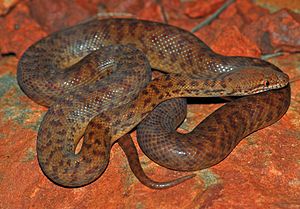Perth dwarf python
| Perth dwarf python | ||||||||||||
|---|---|---|---|---|---|---|---|---|---|---|---|---|

Perth dwarf python ( Antaresia perthensis ) |
||||||||||||
| Systematics | ||||||||||||
|
||||||||||||
| Scientific name | ||||||||||||
| Antaresia perthensis | ||||||||||||
| ( Stull , 1932) |
The Perth dwarf python ( Antaresia perthensis ) is a species from the genus Antaresia in the family of the pythons (Pythonidae). The species epitheton perthensis was assigned because it was wrongly assumed in the first description that the type specimen had been caught near Perth , where the species does not occur. The English trivial names "Pygmy python" ("dwarf python") or "Ant-hill python" ("ant hill python") refer to the small size and preferred shelter of the animals.
features
With a length of 40 to 70 cm, the Perth dwarf python is the smallest Antaresia species. The head is short and flat with a broad, rounded snout and only slightly separated from the neck. The eyes are large and have a reddish brown iris . The upper side of the body is reddish-brown with dark to red-brown spots of different sizes; this pattern fades with age. The ventral side is cream to white and unpatterned.
As a rule, there is an anterior pair of prefrontals adjacent to the pair of internasal shields and two rear pairs of prefrontalia . Only one supraocular shield and usually a pair of parietal shields are typical . There are 4 to 10 Loreal shields , 9 to 14 supralabial shields, and 11 to 15 infralabial shields . Of the latter, the rearmost three, rarely four, carry heat pits. The trunk has 31 to 35 oblique rows of smooth scales in the middle, 212 to 250 ventral shields , 34 to 45 sub-caudal shields and an undivided anal shield .
Distribution and way of life
The Perth dwarf python is endemic to west-central western Australia in the Pilbara region as well as on some coastal islands. As a habitat, he prefers hilly terrain with rocks, caves and termite structures as hiding places. Reptiles and small mammals serve as prey.
The mating takes place in the Australian winter. The clutch consists of two to six large eggs, and the young hatch after about two months.
swell
- Ludwig Trutnau : Non-poisonous snakes, part 1 . 4th edition. Eugen Ulmer GmbH & Co., Stuttgart 2002, ISBN 3-8001-3223-0 .
- RT Hoser: Ant-hill pythons (Antaresia perthensis) in the wild and captivity . In: Monitor . tape 10 , 1999, p. 33-37 (English).